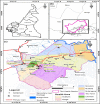A cross-sectional survey on the prevalence of anaemia and malnutrition in primary school children in the Tiko Health District, Cameroon
- PMID: 31223401
- PMCID: PMC6560948
- DOI: 10.11604/pamj.2019.32.111.15728
A cross-sectional survey on the prevalence of anaemia and malnutrition in primary school children in the Tiko Health District, Cameroon
Abstract
Introduction: Anaemia and malnutrition are common health problems in developing countries with children being the most vulnerable. They have negative impacts on human performance, growth and development, in children, both as cause and consequences of disease. Although annual mass deworming and nutrition supplement strategies have been implemented in the Tiko Health District (THD), no study has been carried out to determine the prevalence of anaemia and malnutrition. The aim of this study was therefore designed to determine the prevalence of anaemia and malnutrition among primary school children aged 5-15 years in the Tiko Health District.
Methods: A cross-sectional study was carried out in 10 randomly selected schools in the THD and a total of 400 school children were enrolled in the study. Body weight and height were measured using an electronic weighing scale and stadiometer respectively. Anthropometric indices: Height-for-Age Z scores (HAZ), Weight-for-Age Z scores (WAZ) and Body Mass Index-for-Age Z scores (BMIAZ) were analyzed and compared with WHO Growth Reference Standards using WHO Anthroplus software. Hemoglobin levels were determined using Urit-12 Haemoglobinometer and anaemia defined as Hemoglobin (Hb) < 11g/dl. Data analysis was done using the SPSS software.
Results: The overall prevalence of malnutrition was 9.25%, prevalence of stunting 7.5% with 0.8% being severely stunted. The prevalence of wasting was 1% and underweight 0.7%. The overall prevalence of anaemia was 5%. Parents occupation and the absence of toilet were statistically associated with anaemia (P = 0.04 and P = 0.003). Age, floor type, absence of toilet and BMI were significantly associated with malnutrition (P = 0.00, P = 0.01, P = 0.02 and P = 0.003).
Conclusion: This study revealed a low prevalence of malnutrition and anaemia which could be attributed to the deworming and nutrition supplement strategies which have been implemented.
Keywords: Anaemia; malnutrition; predictors; prevalence; school children; stunting; underweight; wasting.
Conflict of interest statement
The authors declare no competing interests.
Figures
Similar articles
-
Effects of intestinal parasitic infections on nutritional status of primary children in Imo State Nigeria.Pan Afr Med J. 2019 May 16;33:34. doi: 10.11604/pamj.2019.33.34.17099. eCollection 2019. Pan Afr Med J. 2019. PMID: 31384349 Free PMC article.
-
Socio-demographic determinants of malnutrition among primary school aged children in Enugu, Nigeria.Pan Afr Med J. 2017 Nov 21;28:248. doi: 10.11604/pamj.2017.28.248.13171. eCollection 2017. Pan Afr Med J. 2017. PMID: 29942407 Free PMC article.
-
Does Chile's nutritional situation constitute a double burden?Am J Clin Nutr. 2014 Dec;100(6):1623S-7S. doi: 10.3945/ajcn.114.083790. Epub 2014 Oct 29. Am J Clin Nutr. 2014. PMID: 25411304
-
Stunting, wasting and underweight as indicators of under-nutrition in under five children from developing Countries: A systematic review.Diabetes Metab Syndr. 2021 Sep-Oct;15(5):102243. doi: 10.1016/j.dsx.2021.102243. Epub 2021 Aug 12. Diabetes Metab Syndr. 2021. PMID: 34403951
-
Review of the nutrition situation in the Eastern Mediterranean Region.East Mediterr Health J. 2018 Apr 5;24(1):77-91. East Mediterr Health J. 2018. PMID: 29658624 Review.
Cited by
-
An assessment of the nutritional status of internally displaced school children in the West and Littoral Regions of Cameroon.Food Sci Nutr. 2024 Apr 21;12(6):4086-4099. doi: 10.1002/fsn3.4068. eCollection 2024 Jun. Food Sci Nutr. 2024. PMID: 38873487 Free PMC article.
-
Anemia prevalence and associated factors among school-children of Kersa Woreda in eastern Ethiopia: A cross-sectional study.PLoS One. 2023 Mar 24;18(3):e0283421. doi: 10.1371/journal.pone.0283421. eCollection 2023. PLoS One. 2023. PMID: 36961776 Free PMC article.
-
Anaemia, iron deficiency and inflammation prevalence in children in the Mount Cameroon area and the contribution of inflammatory cytokines on haemoglobin and ferritin concentrations: a cross sectional study.BMC Nutr. 2023 Jul 28;9(1):94. doi: 10.1186/s40795-023-00748-3. BMC Nutr. 2023. PMID: 37507740 Free PMC article.
-
Iodine Deficiency Disorders as a Predictor of Stunting among Primary School Children in the Aseer Region, Southwestern Saudi Arabia.Int J Environ Res Public Health. 2021 Jul 18;18(14):7644. doi: 10.3390/ijerph18147644. Int J Environ Res Public Health. 2021. PMID: 34300095 Free PMC article.
-
Confounding influences of malnutrition and Plasmodium falciparum and Schistosoma haematobium infections on haematological parameters in school children in Muyuka, Cameroon.BMC Infect Dis. 2021 May 25;21(1):477. doi: 10.1186/s12879-021-06201-9. BMC Infect Dis. 2021. PMID: 34034666 Free PMC article.
References
-
- WHO . Worldwide prevalence of anaemia. Global Database on Anaemia; 2008.
-
- McLean E, Cogswell M, Egli I, Wojdyla D, de Benoist B. Worldwide prevalence of anaemia, WHO Vitamin and Mineral Nutrition Information System, 1993-2005. Public health nutrition. 2009 Apr;12(4):444–54. - PubMed
-
- Stevens GA, Finucane MM, De-Regil LM, Paciorek CJ, Flaxman SR, Branca F, et al. Global, regional, and national trends in haemoglobin concentration and prevalence of total and severe anaemia in children and pregnant and non-pregnant women for 1995-2011: a systematic analysis of population-representative data. The Lancet Global health. 2013 Jul;1(1):e16–25. - PMC - PubMed
-
- Pasricha S-R, Kassebaum N, Jasrasaria R, Naghavi M, DeMaeyer E, Adiels-Tegman M, et al. Anemia: a comprehensive global estimate. Blood. 2014 Jan 30;123(5):611–2. - PubMed
MeSH terms
LinkOut - more resources
Full Text Sources
Medical


